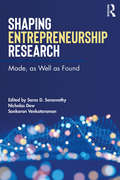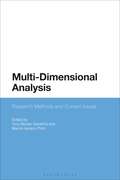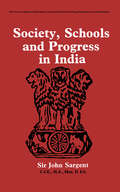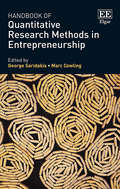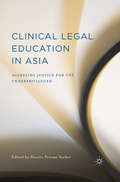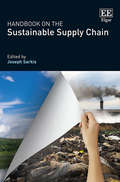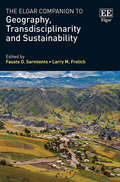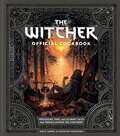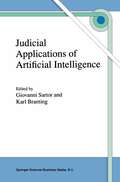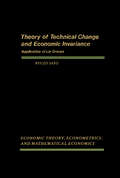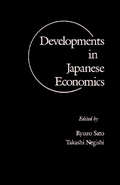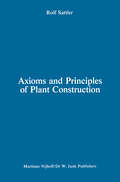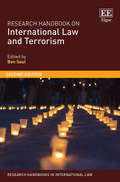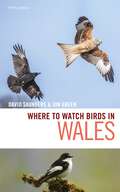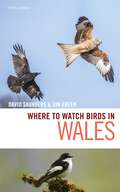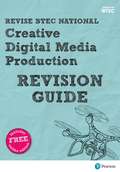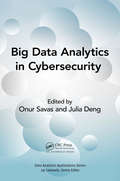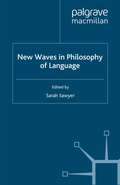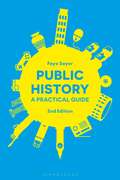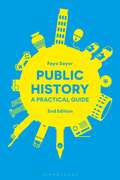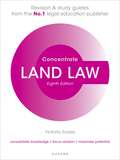- Table View
- List View
Shaping Entrepreneurship Research: Made, as Well as Found
by Saras D. Sarasvathy Nicholas Dew Sankaran VenkataramanShaping Entrepreneurship Research: Made, as Well as Found is a collection of readings designed to support entrepreneurship research. Focused on a worldview in which the future is open-ended and shapeable through human action – i.e. “made”, this collection reframes entrepreneurship as a science of the artificial rather than as a natural or social science. It posits an open-ended universe for the making of human artifacts even if large swathes of nature and society are not within the control of the people making them. The book explores the notion of “made” through 25 foundational readings – classics from the history of ideas. Organized into five sections, each classic is individually introduced by the editors in one of five chapters written to explain its relevance and significance for a “made” view of entrepreneurship. Readers will benefit from exposure to these classic ideas and ongoing research in a variety of areas that fall somewhat outside the line-of-sight of traditional entrepreneurship research. Both individually and collectively, the readings suggest opportunities to ask new questions and develop new ways of framing entrepreneurship research that carry the discussion beyond worlds found to worlds made as well as found. The book is crafted to be valuable to three groups of scholars: young scholars with limited or no access to research infrastructure but with a desire to participate in deep conversations; young scholars with access to research infrastructure who also desire to listen-in on a different kind of conversation; and established entrepreneurship scholars who are contemplating an alternative set of foundational ideas to support their conversations in the discipline.
Multi-Dimensional Analysis: Research Methods and Current Issues
by Tony Berber Sardinha Marcia Veirano PintoMulti-dimensional Analysis: Research Methods and Current Issues provides a comprehensive guide both to the statistical methods in Multi-dimensional Analysis (MDA) and its key elements, such as corpus building, tagging, and tools. The major goal is to explain the steps involved in the method so that readers may better understand this complex research framework and conduct MD research on their own.Multi-dimensional Analysis is a method that allows the researcher to describe different registers (textual varieties defined by their social use) such as academic settings, regional discourse, social media, movies, and pop songs. Through multivariate statistical techniques, MDA identifies complementary correlation groupings of dozens of variables, including variables which belong both to the grammatical and semantic domains. Such groupings are then associated with situational variables of texts like information density, orality, and narrativity to determine linguistic constructs known as dimensions of variation, which provide a scale for the comparison of a large number of texts and registers.This book is a comprehensive research guide to MDA.
Multi-Dimensional Analysis: Research Methods and Current Issues
by Tony Berber Sardinha Marcia Veirano PintoMulti-dimensional Analysis: Research Methods and Current Issues provides a comprehensive guide both to the statistical methods in Multi-dimensional Analysis (MDA) and its key elements, such as corpus building, tagging, and tools. The major goal is to explain the steps involved in the method so that readers may better understand this complex research framework and conduct MD research on their own.Multi-dimensional Analysis is a method that allows the researcher to describe different registers (textual varieties defined by their social use) such as academic settings, regional discourse, social media, movies, and pop songs. Through multivariate statistical techniques, MDA identifies complementary correlation groupings of dozens of variables, including variables which belong both to the grammatical and semantic domains. Such groupings are then associated with situational variables of texts like information density, orality, and narrativity to determine linguistic constructs known as dimensions of variation, which provide a scale for the comparison of a large number of texts and registers.This book is a comprehensive research guide to MDA.
Society, Schools and Progress in India: The Commonwealth and International Library: Education and Educational Research Division
by John SargentSociety, Schools and Progress in India
Read On…Audiobooks: Reading Lists for Every Taste (Read On Series)
by Joyce G. SaricksWith more than 300 original annotations in some 60 thematic lists, this one-of-a kind compilation opens the world of audiobooks to listeners and librarians alike.The demand for audiobooks is booming, yet materials that help listeners make choices of what to listen to have been in short supply. Read On…Audiobooks: Reading Lists for Every Taste fills that gap, helping match reader interests and mood to titles that might please them. Written by Joyce G. Saricks, a well-known writer and speaker on readers' advisory, the book offers original annotations for more than 300 audiobook titles, grouped according to some 60 themes, fiction and nonfiction. Lists are organized by character, story, setting, language, and mood/tone. Each entry provides a plot description and discusses the appeal of the narrator. In addition to helping patrons, the book will assist librarians with collection development and listener's advisory, creating displays that include audiobooks, promoting the collection, and especially, with understanding the special dynamic that exists among listeners, narrators, and audiobooks.
Handbook of Quantitative Research Methods in Entrepreneurship
by George Saridakis Marc CowlingThis Handbook of Quantitative Research Methods in Entrepreneurship provides an overarching perspective on the methods and approaches critical to quantitative analysis of research on entrepreneurship. Representing the research efforts of 28 international scholars in entrepreneurship, this Handbook offers guidance for quantitative analysts at a time of increasing availability of economic, financial and business data. Contributions focus on a range of important empirical issues, including business survival, job creation, internationalisation, bank financing and specific types of entrepreneurial activity such as social enterprise and family business. The combined chapters synthesise and experiment with useful methods to navigate and unpack crucial entrepreneurial data. Informative and accessible, this Handbook is crucial reading for undergraduate and postgraduate students looking for a broad overview of the field. It will also be useful to established academics and researchers who require state of the art research, and policymakers and practitioners, who may use this book as an indispensable guide for reflecting on public interventions in the entrepreneurial arena.
Clinical Legal Education in Asia: Accessing Justice for the Underprivileged
by Shuvro Prosun SarkerThis book describes the history, present status and possible future models of clinical legal education (CLE) in 12 Asian countries, with particular focus on the Asian character of CLE as it has evolved in different countries.
Handbook on the Sustainable Supply Chain (Research Handbooks in Business and Management series)
by Joseph SarkisSupply chain management has long been a feature of industry and commerce but, with increasing demands from consumers, producers are spending more time and money investing in ways to make supply chains more sustainable. This exemplary Handbook provides readers with a comprehensive overview of current research on sustainable supply chain management. Multi-disciplinary in scope, the Handbook includes contributions from over 70 expert authors from a variety of areas including management, engineering, accounting, policy studies, innovation, and marketing. Chapters analyze the three core areas of sustainable supply chain management: environmental, economic, and social. The Handbook explores broad themes such as globalization and general organization strategies as well as examining more specific topics including particular industries, social and regulatory dimensions, and technological advances. Scholars and advanced business and management students will greatly benefit from the depth of analysis in this Handbook as well as the suggestions for directions for future research and practice. Written in an accessible style, it is also ideal for practitioners and government agencies seeking solutions to practical issues regarding sustainable supply chain management.
The Elgar Companion to Geography, Transdisciplinarity and Sustainability
by Fausto O. Sarmiento Larry M. FrolichOffering a cutting-edge, transdisciplinary approach to biophysical and biocultural scales of sustainability, this Companion explores diverse understandings of the what, how, why and where questions of sustainability. It examines the key notion of how to optimize human quality of life whilst minimizing environmental suffering. Integrating a range of disciplines through the social sciences, natural sciences and arts and humanities, this Companion focuses on the human component of sustainability, using a place-based and lifescape approach to environmental questions. Chapters analyze critical topics including urbanization and city life, environmental conservation and rural landscapes, long-term interactions with natural life, climate change and the importance of mountain regions. Looking beyond an economic analysis of sustainability and well-being, this Companion incorporates cross-cutting social, cultural, judicial and spiritual dimensions of sustainability and regenerative development. With a combination of international case studies and an interdisciplinary framework for understanding the topic, this will be an interesting read for those studying sustainability from a range of disciplinary bases including ecological economists, human ecologists and geographers. It will also be beneficial to urban planners and ecologists interested in how the profoundly impactful evolutionary trend towards the urban environment is effecting human geographies around the world.
The Witcher Official Cookbook: 80 mouth-watering recipes from across The Continent
by Anita Sarna Karolina KrupeckaTake a culinary journey through the fantastical world of The Witcher with thoughtfully imagined, flavorful recipes inspired by The Witcher's expansive settings, characters, and lore. In this beautifully photographed cookbook, Anita Sarna and Karolina Krupecka, the creators of fan-favorite food blogs Nerds' Kitchen and Witcher Kitchen, share their meticulously-researched, immersive recipes that give fans a taste of the distinct flavors a witcher might sample as he travels the countryside in search of monsters to slay and coin to earn.These dishes celebrate local and seasonal ingredients while adding unique twists that form a culinary map of the Continent and beyond. Warm up over a bowl of fragrant stew or juicy baked fruit from the namesake trees of White Orchard; end a hard journey to Velen with a hearty, rustic meal at the local tavern; enjoy an aromatic snack as you stroll the markets of Oxenfurt; sample dishes from near and far in the diverse port city of Novigrad; dine on freshly-caught fish and mulled drinks on the islands of Skellige; feast on rich dishes in the sun-drenched climates of Toussaint and Beauclair; or forage on the perilous road to Kaer Morhen to learn the edible secrets of the witcher's keep. Transport your kitchen to another world with the tempting scents and flavors in The Witcher Official Cookbook. CD PROJEKT(R), The Witcher(R) are registered trademarks of CD PROJEKT Capital Group. The Witcher game (c) CD PROJEKT S.A. Developed by CD PROJEKT S.A. All rights reserved. The Witcher game is set in the universe created by Andrzej Sapkowski in his series of books. All other copyrights and trademarks are the property of their respective owners.
Judicial Applications of Artificial Intelligence
by Giovanni SartorThe judiciary is in the early stages of a transformation in which AI (Artificial Intelligence) technology will help to make the judicial process faster, cheaper, and more predictable without compromising the integrity of judges' discretionary reasoning. Judicial decision-making is an area of daunting complexity, where highly sophisticated legal expertise merges with cognitive and emotional competence. How can AI contribute to a process that encompasses such a wide range of knowledge, judgment, and experience? Rather than aiming at the impossible dream (or nightmare) of building an automatic judge, AI research has had two more practical goals: producing tools to support judicial activities, including programs for intelligent document assembly, case retrieval, and support for discretionary decision-making; and developing new analytical tools for understanding and modeling the judicial process, such as case-based reasoning and formal models of dialectics, argumentation, and negotiation. Judges, squeezed between tightening budgets and increasing demands for justice, are desperately trying to maintain the quality of their decision-making process while coping with time and resource limitations. Flexible AI tools for decision support may promote uniformity and efficiency in judicial practice, while supporting rational judicial discretion. Similarly, AI may promote flexibility, efficiency and accuracy in other judicial tasks, such as drafting various judicial documents. The contributions in this volume exemplify some of the directions that the AI transformation of the judiciary will take.
Endosymbiotic Theories of Organelles Revisited: Retrospects and Prospects
by Naoki SatoThis book re-examines the endosymbiotic theory, and presents various related theories and hypotheses since the first proposal in 1905 by a Russian biologist. It also demonstrates that Lynn Margulis’s contribution to the current endosymbiotic is less than sometimes thought, and presents a plausible idea on how the organelles were formed. Explaining that Margulis’s initial work did not intend to show the endosymbiotic origin of chloroplasts and mitochondria, the book discusses their endosymbiotic origin in the light of current biology with the help of clear visual images. Further, by including numerous historical facts and details of phylogenetic analyses using recent genomic data that are largely unknown to many in the field, it offers deep insights into the history of biology, phylogenetic analysis, and the new evolutionary thinking. 2017 was the 50-year anniversary of Margulis’s first paper in the Journal of Theoretical Biology, and 2020 will mark 50 years since the publication her famous work Origin of Eukaryotic Cells, and as such this book offers a timely reconsideration ofthe works of Lynn Margulis and the endosymbiotic origin of organelles.
Theory of Technical Change and Economic Invariance: Application of Lie Groups
by Ryuzo SatoTheory of Technical Change and Economic Invariance: Application of Lie Groups presents the economic invariance problems observable behavior under general transformations such as taste change or technical change. This book covers a variety of topics in economic theory, ranging from the analysis of production functions to the general recoverability problem of optimal dynamic behavior.Organized into nine chapters, this book begins with an overview of the theory of observable behavior by analyzing the invariant relationships among economic variables. This text then examines the Lie group theory which provides one of the most efficient methods of studying invariance properties. Other chapters consider the analysis of exogenous technical change, a process partly due to dynamic market forces of supply and demand. This book discusses as well the topics closely related to parametric changes under Lie groups and related transformations. The final chapter deals with mathematical foundations of the theory of observable market behavior.This book is a valuable resource for economists.
Developments in Japanese Economics
by Ryuzo Sato Takashi NegishiDevelopments in Japanese Economics provides information pertinent to the fundamental aspects of the developments in Japanese economics. This book presents the process innovative aspect of Japanese science and technology.Organized into three parts encompassing 12 chapters, this book begins with an overview of the heterogeneous capital goods model that is stable even with an infinitely short forecast. This text then emphasizes that the changes in capital accumulation are relevant for economic growth and decline. Other chapters consider the examples of how Japanese economists apply theory to empirical endeavors. This book discusses as well the durable capital stock of the Japanese manufacturing industries. The final chapter attempts to investigate the validity of the theory of self-dual demand functions, which can be integrated into consumer's utility function, by using both Japanese and U.S. data.This book is a valuable resource for economists, sociologists, political scientists, financial historians, statisticians, and research workers.
Axioms and Principles of Plant Construction: Proceedings of a symposium held at the International Botanical Congress, Sydney, Australia, August 1981
by R. SattlerThis volume presents the proceedings of a symposium which I organised for the Developmental Section of the Xlllth International Botanical Congress at Sydney, Australia on August 26, 1981. The paper by Professor T. Sachs, which was received too late for inclusion into the symposium at Sydney, was added to these proceedings because of its direct relevancy and importance. The aim of the symposium was to state in an explicit and comprehensive fashion the most basic axioms and principles of plant morphology and morphogenesis. An awareness of these axioms and principles is of paramount importance since they form. the foundations as well as the goal of structural developmental botany. Both teaching and research are predicated on them. The Introduction by the editor briefly examines the meaning of the concepts "axiom", "principle", and "plant construction". The comprehensive paper by Dr. G. Cusset, a unique historical overview, explicates 37 principles of 5 major conceptual systems and many subsystems. The extensive analysis includes a genealogy of ideas and ways of thinking of major authors ranging from philosophers and naturalists of antiquity to recent investigators of plant form and structure. The bibliography of Dr. Cusset I s paper comprises ca. 700 references. The contribution by Professor H. Mohr focusses on modern principles of morphogenesis and provides a penetrating analysis of scientific explanation in developmental biology. The universal principles (laws) described in this paper apply to all living systems, whereas the more specific principles are limited to plants or only higher plants. Professor T.
Research Handbook on International Law and Terrorism (Research Handbooks in International Law series)
by Ben SaulThis newly revised and updated second edition of the Research Handbook on International Law and Terrorism provides a comprehensive overview of international counter-terrorism law and practice from the perspectives of human rights, the law of armed conflict, the law on use of force, and international criminal law. Brand new and revised chapters provide critical commentary on the law from leading scholars and practitioners in the field. Major controversies in the global legal response to terrorism are examined, including up-to-date analyses of the war on terror, drone strikes and targeted killings, torture and rendition, indefinite detention, military trials, and UN Security Council measures and sanctions. New topics for this edition are assessed, focusing on foreign terrorist fighters, the nexus between organized crime and terrorism, and the prevention of violent extremism. Exploring developments from before and after the terrorist attacks of 9/11, the Research Handbook also includes new analysis of contemporary threats such as Islamic State, and discusses the law of regional organizations and selected national practice. International law scholars and practitioners, as well as government and United Nations legal advisers, will find this an invaluable reference on a complex area of legal inquiry. It will also prove a critical read for academics and students in international relations, terrorism studies, security studies, war studies, and human rights.
Where to Watch Birds in Wales (Where to Watch Birds)
by David Saunders Jon GreenThe definitive guide to the birdwatching sites of Wales.Wales remains one of the most alluring regions for birdwatchers; its range of habitats ensures a wide variety of species amidst the often spectacular scenery. Now in its fifth edition, Where to Watch Birds in Wales remains an invaluable and most trusted site guide for birdwatching in Wales. This new edition features many new sites, and includes updated maps to the sites and fully revised and expanded text.This is an essential guide for all birdwatchers living in or visiting this land of hills, valleys, moors and mountains.
Where to Watch Birds in Wales (Where to Watch Birds)
by David Saunders Jon GreenThe definitive guide to the birdwatching sites of Wales.Wales remains one of the most alluring regions for birdwatchers; its range of habitats ensures a wide variety of species amidst the often spectacular scenery. Now in its fifth edition, Where to Watch Birds in Wales remains an invaluable and most trusted site guide for birdwatching in Wales. This new edition features many new sites, and includes updated maps to the sites and fully revised and expanded text.This is an essential guide for all birdwatchers living in or visiting this land of hills, valleys, moors and mountains.
Revise BTEC National Creative Digital Media Production Revision Guide (REVISE BTEC Nationals in Creative Digital Media Production)
by Nigel SaundersOur revision resources are the smart choice for those revising for the externally assessed units in Creative Digital Media Production BTEC Nationals from 2017. This book will help you to: • Revise all the essential content and key skills for each unit • Organise your revision with the one-topic-per-page format • Speed up your revision with helpful hints on how to tackle questions and tasks • Track your revision progress with at-a-glance check boxes • Check your understanding with annotated example responses • Practise with revision questions, with answers
Big Data Analytics in Cybersecurity (Data Analytics Applications)
by Onur Savas Julia DengBig data is presenting challenges to cybersecurity. For an example, the Internet of Things (IoT) will reportedly soon generate a staggering 400 zettabytes (ZB) of data a year. Self-driving cars are predicted to churn out 4000 GB of data per hour of driving. Big data analytics, as an emerging analytical technology, offers the capability to collect, store, process, and visualize these vast amounts of data. Big Data Analytics in Cybersecurity examines security challenges surrounding big data and provides actionable insights that can be used to improve the current practices of network operators and administrators. Applying big data analytics in cybersecurity is critical. By exploiting data from the networks and computers, analysts can discover useful network information from data. Decision makers can make more informative decisions by using this analysis, including what actions need to be performed, and improvement recommendations to policies, guidelines, procedures, tools, and other aspects of the network processes. Bringing together experts from academia, government laboratories, and industry, the book provides insight to both new and more experienced security professionals, as well as data analytics professionals who have varying levels of cybersecurity expertise. It covers a wide range of topics in cybersecurity, which include: Network forensics Threat analysis Vulnerability assessment Visualization Cyber training. In addition, emerging security domains such as the IoT, cloud computing, fog computing, mobile computing, and cyber-social networks are examined. The book first focuses on how big data analytics can be used in different aspects of cybersecurity including network forensics, root-cause analysis, and security training. Next it discusses big data challenges and solutions in such emerging cybersecurity domains as fog computing, IoT, and mobile app security. The book concludes by presenting the tools and datasets for future cybersecurity research.
Big Data Analytics in Cybersecurity (Data Analytics Applications)
by Onur Savas Julia DengBig data is presenting challenges to cybersecurity. For an example, the Internet of Things (IoT) will reportedly soon generate a staggering 400 zettabytes (ZB) of data a year. Self-driving cars are predicted to churn out 4000 GB of data per hour of driving. Big data analytics, as an emerging analytical technology, offers the capability to collect, store, process, and visualize these vast amounts of data. Big Data Analytics in Cybersecurity examines security challenges surrounding big data and provides actionable insights that can be used to improve the current practices of network operators and administrators. Applying big data analytics in cybersecurity is critical. By exploiting data from the networks and computers, analysts can discover useful network information from data. Decision makers can make more informative decisions by using this analysis, including what actions need to be performed, and improvement recommendations to policies, guidelines, procedures, tools, and other aspects of the network processes. Bringing together experts from academia, government laboratories, and industry, the book provides insight to both new and more experienced security professionals, as well as data analytics professionals who have varying levels of cybersecurity expertise. It covers a wide range of topics in cybersecurity, which include: Network forensics Threat analysis Vulnerability assessment Visualization Cyber training. In addition, emerging security domains such as the IoT, cloud computing, fog computing, mobile computing, and cyber-social networks are examined. The book first focuses on how big data analytics can be used in different aspects of cybersecurity including network forensics, root-cause analysis, and security training. Next it discusses big data challenges and solutions in such emerging cybersecurity domains as fog computing, IoT, and mobile app security. The book concludes by presenting the tools and datasets for future cybersecurity research.
New Waves in Philosophy of Language (New Waves in Philosophy)
by S. SawyerInnovative young philosophers present new research articles on a variety of contemporary issues including relation between language and thought, normativity of language, prospects for a naturalistic account of language, nature of linguistic understanding, semantics of proper names and expressive terms, a contemporary construal of analytic truth
Public History: A Practical Guide
by Faye SayerThe 2nd edition of Public History: A Practical Guide provides a fresh examination of history as practiced in its various worldly guises and contexts. It analyses the many skills that historians require in the practice of public history and looks at how a range of actors, including museums, archives, government agencies, community history societies and the media/digital media, make history accessible to a wider audience in a variety of ways.Faye Sayer's exciting new edition includes: * Brand new chapters on 'Restoration and Preservation' and history and the working world* Substantial additions covering the growing fields of digital history and history in politics* More images, figures and international case studies from the US, Australia, the UK, Europe and Asia* 'Personal Reflection' sections from a range of industry experts from around the world* Historiographical updates and significant revisions throughout the text* Expanded online 'Public History Toolkit' resource, with a range of new features Public History: A Practical Guide delivers a comprehensive outline of this increasingly prevalent area of the discipline, offering a distinctly global approach that is both accessible and engaging in equal measure. Finally, it explores future methodological possibilities and can be used as a reference point for professional development planning in the sectors discussed. This is the essential overview for any student wanting to know what history means beyond the classroom.
Public History: A Practical Guide
by Faye SayerThe 2nd edition of Public History: A Practical Guide provides a fresh examination of history as practiced in its various worldly guises and contexts. It analyses the many skills that historians require in the practice of public history and looks at how a range of actors, including museums, archives, government agencies, community history societies and the media/digital media, make history accessible to a wider audience in a variety of ways.Faye Sayer's exciting new edition includes: * Brand new chapters on 'Restoration and Preservation' and history and the working world* Substantial additions covering the growing fields of digital history and history in politics* More images, figures and international case studies from the US, Australia, the UK, Europe and Asia* 'Personal Reflection' sections from a range of industry experts from around the world* Historiographical updates and significant revisions throughout the text* Expanded online 'Public History Toolkit' resource, with a range of new features Public History: A Practical Guide delivers a comprehensive outline of this increasingly prevalent area of the discipline, offering a distinctly global approach that is both accessible and engaging in equal measure. Finally, it explores future methodological possibilities and can be used as a reference point for professional development planning in the sectors discussed. This is the essential overview for any student wanting to know what history means beyond the classroom.
